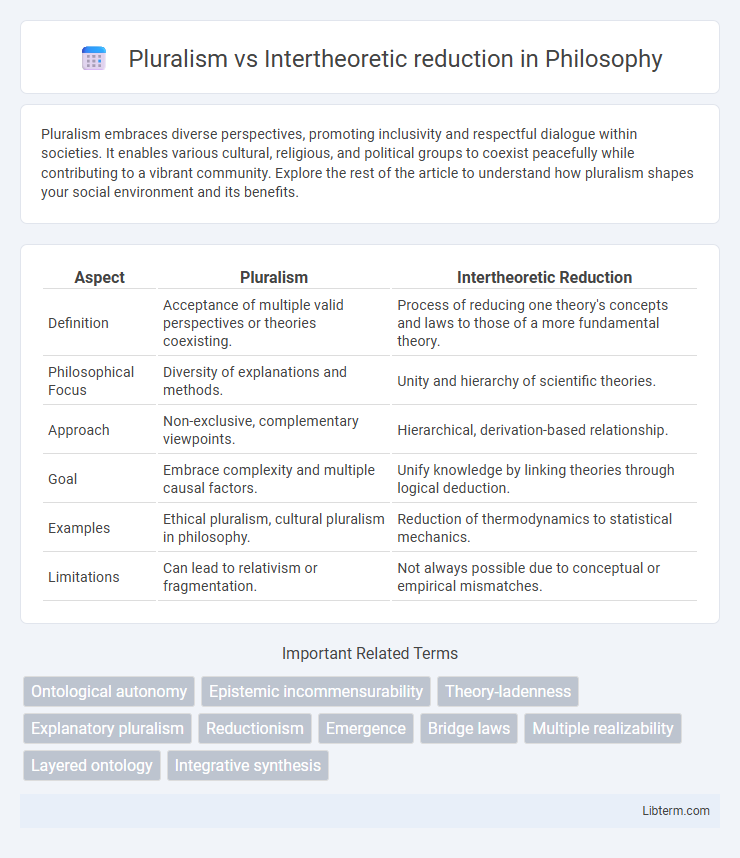Pluralism embraces diverse perspectives, promoting inclusivity and respectful dialogue within societies. It enables various cultural, religious, and political groups to coexist peacefully while contributing to a vibrant community. Explore the rest of the article to understand how pluralism shapes your social environment and its benefits.
Table of Comparison
| Aspect | Pluralism | Intertheoretic Reduction |
|---|---|---|
| Definition | Acceptance of multiple valid perspectives or theories coexisting. | Process of reducing one theory's concepts and laws to those of a more fundamental theory. |
| Philosophical Focus | Diversity of explanations and methods. | Unity and hierarchy of scientific theories. |
| Approach | Non-exclusive, complementary viewpoints. | Hierarchical, derivation-based relationship. |
| Goal | Embrace complexity and multiple causal factors. | Unify knowledge by linking theories through logical deduction. |
| Examples | Ethical pluralism, cultural pluralism in philosophy. | Reduction of thermodynamics to statistical mechanics. |
| Limitations | Can lead to relativism or fragmentation. | Not always possible due to conceptual or empirical mismatches. |
Introduction to Pluralism and Intertheoretic Reduction
Pluralism recognizes the coexistence of multiple theories or perspectives to explain phenomena, emphasizing the value of diverse frameworks without insisting on their unification. Intertheoretic reduction seeks to unify scientific theories by demonstrating that one theory can be systematically derived from or translated into a more fundamental theory, aiming for theoretical simplification. Both approaches address the problem of theory choice and integration in philosophy of science, with pluralism supporting theoretical diversity and intertheoretic reduction emphasizing coherence and hierarchical organization.
Defining Pluralism in Scientific Theories
Pluralism in scientific theories asserts that multiple, distinct theoretical frameworks can coexist, each offering valid explanations for complex phenomena without being entirely reducible to one another. This perspective contrasts sharply with intertheoretic reduction, which seeks to unify theories by showing how one can be subsumed under or logically derived from a more fundamental theory. Emphasizing epistemic diversity, pluralism acknowledges the limitations of single-theory approaches and promotes a multifaceted understanding of scientific knowledge.
Understanding Intertheoretic Reduction
Intertheoretic reduction involves explaining the concepts and laws of one scientific theory by means of those belonging to a more fundamental theory, establishing a hierarchical relationship between theories. This process requires precise definitions and bridge laws to correlate terms and empirical content, ensuring consistency and coherence across different theoretical frameworks. In contrast to pluralism, which accepts multiple incompatible theories as equally valid, intertheoretic reduction aims to unify and simplify scientific understanding by integrating diverse theories under a single, overarching explanatory scheme.
Historical Development of Both Approaches
Pluralism in philosophy and science emphasizes the coexistence of multiple theories, emerging prominently in the early 20th century as a response to the limitations of monistic frameworks. Intertheoretic reduction, developed through the logical positivist movement and formalized by figures like Ernest Nagel, gained traction mid-20th century by aiming to unify sciences via systematic theory reduction. The historical development of pluralism and intertheoretic reduction reflects contrasting responses to scientific complexity, with pluralism advocating for independent explanatory models and reductionism striving for conceptual and empirical unity.
Key Arguments for Pluralism
Pluralism advocates for the coexistence of multiple theories, arguing that different scientific frameworks capture distinct aspects of complex phenomena, which intertheoretic reduction often overlooks by attempting to unify theories into one. Key arguments emphasize the epistemic value of diverse perspectives to address varied explanatory goals, promote innovation, and better accommodate anomalies that singular theories may fail to explain. Pluralism also highlights the practical and heuristic benefits of maintaining multiple models to reflect the multifaceted nature of reality in disciplines such as biology, psychology, and social sciences.
Core Principles of Intertheoretic Reduction
Intertheoretic reduction emphasizes the systematic translation of concepts, laws, and models from one theory to another, ensuring that the reducing theory can fully explain the phenomena described by the reduced theory. Core principles include definitional extension, where terms of the reduced theory are explicitly defined within the reducing theory's framework, and the preservation of empirical content, ensuring that observational predictions remain consistent across theories. This approach contrasts with pluralism, which advocates for the coexistence of multiple, sometimes incompatible, theories without requiring reduction or unification.
Case Studies: Pluralism in Practice
Case studies on pluralism in practice demonstrate how embracing multiple theoretical perspectives enhances problem-solving in complex fields such as medicine and environmental science. Researchers integrate diverse models to address multifaceted issues, ensuring more comprehensive and adaptable solutions than rigid intertheoretic reduction approaches. This methodological pluralism fosters innovation by valuing complementary insights rather than simplifying phenomena to a singular, reduced framework.
Case Studies: Successful Reductions
Case studies of successful intertheoretic reductions, such as the reduction of classical thermodynamics to statistical mechanics and Mendelian genetics to molecular genetics, demonstrate clear correspondences between theoretical frameworks that validate unifying scientific explanations. These reductions provide empirical and conceptual bridges, enhancing predictive power and coherence across scientific disciplines without dismissing the value of pluralistic approaches that accommodate diverse explanatory models. Evidence from physics and biology emphasizes that intertheoretic reduction can clarify foundational assumptions, improve explanatory depth, and foster integration within scientific paradigms.
Debates and Critiques in Contemporary Philosophy
Debates in contemporary philosophy center on pluralism's embrace of multiple coexisting theories versus intertheoretic reduction's goal to unify different theories under a single framework. Critics argue that pluralism risks relativism and fragmentation, while detractors of intertheoretic reduction highlight its difficulties in preserving explanatory power across diverse domains. Philosophers continue analyzing whether pluralism's tolerance of diverse perspectives better accommodates scientific progress or if reductionism's coherence fosters deeper understanding.
Future Directions and Ongoing Challenges
Future directions in pluralism and intertheoretic reduction emphasize developing integrative frameworks that accommodate diverse theoretical perspectives while striving for coherence across scientific domains. Ongoing challenges include addressing the epistemological tensions between maintaining theoretical autonomy and achieving reductive unification, especially in complex systems where multiple explanatory levels coexist. Advancements in computational modeling and interdisciplinary methodologies offer promising avenues to reconcile these approaches and enhance the explanatory power of scientific theories.
Pluralism Infographic

 libterm.com
libterm.com